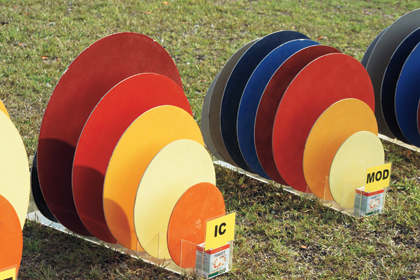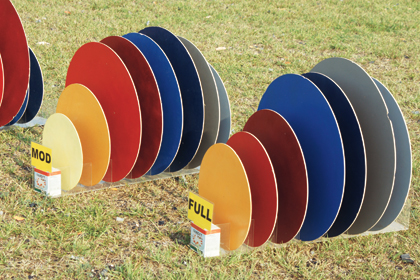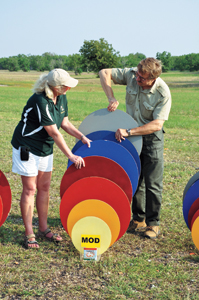September 23, 2010
By Terry Wieland
Seeing shot patterns from a new angle may help you improve your wingshooting performance.
By Terry Wieland
Understanding shotgun chokes and patterns would be a whole lot easier if we could just see exactly what it is we are talking about.
The problem is, we can't. We can't see a pattern of shot while it is in the air, and even if we could, what we saw one nano-second would be changed significantly a nano-second later and no longer in existence, in any form, a second after that.
Advertisement
This fact, more than any other, has fed the lively arguments over chokes, shot sizes, forcing cones, and myriad other changeable factors in shotgun shooting virtually from the time choke was invented in the 1870s.
Although Americans like to think choke was invented by Fred Kimble in 1868, the idea showed up two years earlier in England, patented by gunmaker William Rochester Pape. We can be charitable and assume that Kimble happened on the idea independently, albeit after Pape.
Advertisement
Today, the notion that patterns can be improved by constricting the muzzle of a shotgun may seem so obvious that it's a wonder it wasn't hatched the day after the first load of shot was fired, but that is true of so many things. The wheel, for example. What could be more obvious? But look how many cultures never invented it at all.
The concept of choke has been refined considerably since Pape's day. Early guns had one barrel marked "Choke," denoting a constriction of about .035 inch, and one barrel left unmarked since the alternative to Choke was nothing at all. It was more or less Cylinder (Cyl.), with a constriction of maybe .002 to .005 inch, but early guns were not marked as such.
In England, gunmakers went on to refine choke to degrees measured in fractions--1/4, 1/2, and 3/4. In America, we developed Improved Cylinder (IC) and Modified (M) as the rough equivalents of 1/4 and 1/2. Later, Skeet #1 and #2 were developed purely for skeet shooting, and these constrictions lay between Cyl. and IC.
With the advent of interchangeable choke tubes in the 1980s, makers began to refine the divisions farther and farther, splitting hairs and then splitting them again. Eventually, some marked the constrictions in thousandths, with one tube marked .010, another .015, and so on. Other than adding to the confusion, such divisions have little real impact on how well a shotgunner is likely to do on any given day, whether he is shooting sporting clays, doves over a sunflower field, or woodcock in thick cover.
If you center your pattern on your target, it will make no difference whether your choke is Cylinder or Full. None. However, this does not head off the endless arguments over what choke is appropriate for what use, and that brings us back to the problem outlined above: We cannot see exactly what it is we are arguing about, and so we are free to imagine what happens and then propound that point of view.
Shot Pattern Analysis
The traditional method of measuring a shot pattern is to put up a sheet of paper at 40 yards, fire a load of shot at it, then draw a 30-inch circle around the greatest concentration and count the pellet holes. Relative choke is determined by the percentage of pellets inside the circle compared to the number in the original shot charge. An ounce of #7½s contains 345 pellets; if 242 pellets fall within the circle, that is 70 percent, and hence a Full choke.
 (Top) Gil and Vicki Ash's three-dimensional pattern displays vividly illustrate how effective "killing" choke develops from the muzzle, reaches its peak, and disappears. From left, patterns from Cyl., Skeet, IC, Mod., and Full chokes. The disks are color-coded to indicate distance from the muzzle and carefully sized to the exact diameter of the killing pattern at that distance. Distance in yards: orange, 10; yellow, 15; caramel, 20; red, 25; maroon, 30; medium blue, 35; dark blue, 40; gray, 45; dark gray, 50. (Bottom) Viewed from the rear, it is equally startling to see the way killing patterns drop off. |
There are many shortcomings with this method. For one thing, a sheet of paper is a flat surface, and a shot pattern is three-dimensional. Not all the pellets pierce the paper at the same time. You have no idea how long the pattern is. And actually, if time is the fourth dimension, then a shotgun pattern is four-dimensional--changing continuously as time passes.
The usual accepted ideal for a shot pattern is one that is as long as it is wide and tall--more or less shaped like a beach ball flying through the air. Of course, the pattern evolves continuously after it leaves the muzzle, and even if it attains this shape, it will only retain it for a split second. Hence the 40-yard standard: That is where we would generally, more or less, like our ideal pattern to occur, so that is where we measure it.
Still, two patterns, one close to ideal and the other hideously ragged and elongated, could give identical results when measured on a sheet of paper with a 30-inch circle. Obviously, some better method was needed.
Bob Brister, the writer and shotgun authority, tried to determine the shape of a pattern by firing it at a huge surface that was moving sideways, thereby determining the distance between the leading pellet and the last and giving a rough idea of the pattern's overall shape. This was an improvement, but it was difficult, haphazard (affected as it was by both the velocity of the shot and the speed of the target), and very time consuming.
Brister's work did inspire other researchers, however, trying a variety of methods.
Gil and Vicki Ash, two shotgun instructors from Houston, Texas, took up where Brister left off and, about 15 years ago, began a long process of serious shooting, measuring, and counting in order to find out exactly what a shotgun pattern looks like, from the muzzle to beyond normal killing range. They wanted to find out how each pattern evolves and how it is affected by choke.
What the Ashes discovered, they have described in a number of books and videos, as well as applying it on their instruction range near Houston. When I saw Gil's presentation on chokes in August 2009, it struck me as the first really original findings on chokes and patterns that I have seen in the last 20 years.
The Most Useful Choke
After the invention of choke, double guns were marketed for many years with standard configurations. First came Choke & Cyl.; later came IC/M (usually w
ith shorter barrels) or M/F (with longer barrels). In the U.K., 1/4 & 1/2 was common, or 1/2 and Full.
For skeet shooting, even IC was not open enough, and the wide-open Skeet chokes were substituted on serious skeet guns. In trap shooting, where the target is far away and getting farther, Full choke is favored, with some better shooters choosing Extra Full (80 percent) to ensure more concentration of shot and more spectacularly crushed birds.
However--and this is noteworthy--many a trap shooter has posted consistently excellent scores using Modified choke. And not just novices, either. These guys knew instinctively what others did not, but which the Ashes' tests showed definitively: Modified may well be the single most useful choke of all. And here's why.
 IC develops the classic cone-shaped pattern we all imagine, but it is the only choke that does. It reaches its widest killing pattern (maroon) at 30 yards and drops off rapidly thereafter. At 35 yards, its killing pattern is the same size as Modified's, and at 40 yards, Modified choke has a larger killing pattern than IC. |
 Comparing Modified and Full: Modified develops a killing pattern sooner and holds it longer. No wonder it is such an effective choke for trap shooters. |
Most of us imagine the evolving shape of a shot pattern as simply a cloud that starts to spread, either quickly or slowly, as soon as it leaves the muzzle. A few of the more sophisticated imagine it as a spreading cone. In our imaginations, IC gives a wide cone, Full choke a narrow cone.
Not so, say Gil and Vicki Ash. In fact, anything but. First, they determined the concentration of pellets per square inch that denotes a "killing" pattern. Then they traced killing patterns for each choke. They looked at Cyl., Skeet, IC, Mod., and Full chokes, measuring the impact of the pellets at 5-yard increments starting at 10 yards from the muzzle.The first, and most startling finding, was that every choke maintains a killing concentration of pellets in the center extending straight out from the muzzle--and does so well beyond the usual 40-yard limit. Anyone who has patterned guns knows that the main concentration of shot in any pattern lies in the center--roughly a 15-inch-diameter circle. This concentration of shot, in what is in effect a 15-inch tunnel, is common to all chokes and extends from the muzzle to the end of the pattern's effective life.
Choke does not affect this "core" pattern, only the pellets around the outside. So imagine cones. And now imagine a 15-inch cylinder straight through the middle of each. This rule applies to every choke, from the most open to the most constricted. Choke affects only what happens to the rest of the pellets in the shot load. How those pellets spread, and how quickly, determines the optimum killing pattern and range for each choke. But each choke has a distinct "core" killing pattern and an outer killing pattern.
In the case of Full choke, the pattern expands slowly in a shape that resembles a trumpet. Once the pattern starts to really spread--at around 30 yards--it spreads quickly and maintains a good killing pattern out to 50 yards.
Cylinder, as might be expected, expands very quickly and gives its greatest killing pattern (30 inches) at 25 yards; by 30 yards, the killing pattern has dropped off to only 20 inches, and beyond 30 yards you have only the "core" of about 15 inches. Skeet choke resembles Cyl. very closely but still has a 16-inch killing pattern at 35 yards.
Improved Cylinder is the only choke tested that delivers the classic, perfect cone--expanding into a noticeable pattern at 10 yards and spreading uniformly out to 30 yards where it delivers a 30-inch killing pattern. By 35 yards, however, the pattern has dropped off to only 20 inches.
The real surprise, to me at least and, I believe, to most other shotgunners, is the performance of Modified. The pattern spreads steadily from the muzzle until, at 25 yards, it is a good 25-inch killing pattern. It then maintains this outer killing pattern for a full 20 yards, neither spreading further nor deteriorating, and giving excellent performance from 25 yards to 45 yards, and a still-creditable 20 inches way out there at 50 yards.
Modified may well be the single most useful all-around choke of them all. Obviously, those crafty trap shooters were on to something.
 Vicki Ash and the author with the Mod. pattern. Based on the Ashes' tests, Modified may be the most useful overall choke. |
Shotgunning Implications
For the average shotgunner, all of this information is interesting, but the question is, how can you put it to use?
It is safe to say that Gil and Vicki's tests show that the old-time shotgun makers knew a thing or two. The two classic combinations--IC/M and M/F--are very hard to beat for the average game shooter facing a wide variety of situations, and in three cases out of four, IC/M is probably the best choice.
What amazed me was that at 25 yards Modified has just as good a killing pattern as IC, and at 40 yards a Modified outer killing pattern is considerably better than IC, which is already deteriorating badly.
For practical application of this combination on birds, measure 30 yards and learn to recognize it at a glance. That is both the optimum distance for IC and its maximum, for beyond that it fades rapidly. At 35 yards, Modified takes over, delivering a larger killing pattern than IC, so it is more useful from 30 to 50 yards--the outer limit for this combination.
With M/F, it is less clear cut. However, Modified becomes the more useful of the two by a substantial margin, delivering a smallish (24-inch) but consistent killing pattern from about 35 to 50 yards. Full is at its best for a brief moment at 45 yards. Because birds are rarely at one specific distance for more than a split second, it is obvious that Modified becomes the dependable workhorse choke of this combination.
So if you are a shotgunner with one single-barrel gun, with a fixed choke, who wants to hunt a little of everything in every season under all conditions, what choke should you choose? Modified would be the best choice, followed by IC.
For a double gun, IC/M would probably be the best combination 75 pe
rcent of the time. The key, though, would be to learn exactly what 30 yards looks like and then stick rigorously to shooting the open barrel in close and reverting to Mod. at anything beyond 30 yards. It is a shocking revelation that Mod. has a larger killing pattern at 35 yards than does IC, but it's a fact--a fact that can be put to very effective use.
Gil Ash, standing and looking at his three-dimensional display of choke patterns, told me that he has yet to set up the display without seeing something, some nuance, that he has not noticed before. I feel the same way writing about it. This article only scratches the surface of the lessons that are waiting for any shotgunner willing to take the time and do a little non-shooting study to improve his actual-shooting performance.
The great thing about shotgunning: You never stop learning.
